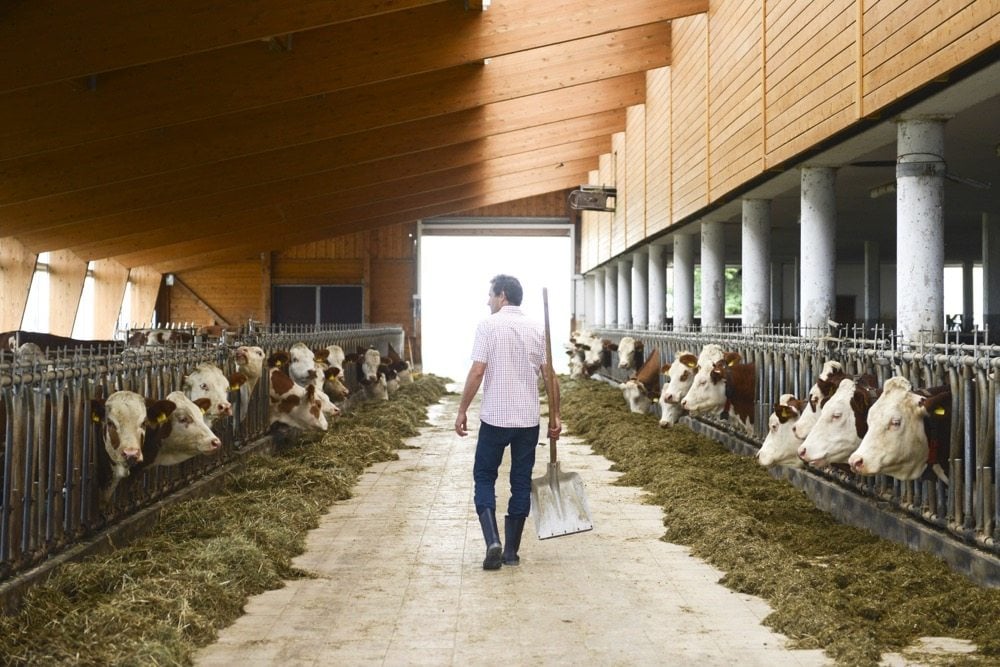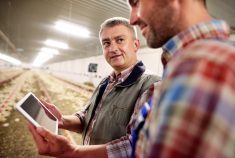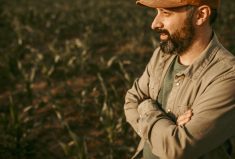No one would really question whether any farmer serving on a commodity or other type of farm board might need some leadership skills. After all, that’s what those farmers are doing, right? They’re being farm leaders. The same goes too for any farmer who manages a large operation with multiple employees. Obviously, if they’ve got a staff, they’re leaders too.
But what about a partnership run by a couple of brothers or cousins, or a typical operation where Mom and Dad are partway through transitioning the decision-making authority to the next generation?
Or, to get right to the point, what about a solo operation? Are they leaders? And will they get a payback from working on their leadership skills?

Denise Filipchuk thinks the answer is yes, at least to a certain extent. As a Backswath Management farm consultant based out of Swan River, Man., she works with farmers on everything from financial analysis to strategic business planning.
Filipchuk’s clients include crop producers, mixed farmers, and farmers with value-added businesses such as seed cleaning plants, seed growing, or trucking. Some of those farms have one leader, she says, while many have small management teams.
Today, she says, all of them are pushing their thinking to a CEO level.
The Test: Developing a vision
It might seem counter-intuitive at first, but it turns out that on a small farm, effective leadership can be even more crucial because every member of the team is so important, and it’s so important to have them all focused on the same end point.
You can’t rely on that happening on its own, Filipchuk says, because each member will operate independently to some extent, and take responsibility for part of the overall operation.

Similarly, Anne Van Delst, an accountant and partner with Ontario accounting firm GGFL, sees leadership as key to making the right decisions for the farm, no matter the size of the management team.
Van Delst grew up on a dairy operation in eastern Ontario so she understands not only the terminology her clients use, but she also understands the family dynamics and the overriding need to get the work done.
“I’ve milked a cow. I get it,” she says.
Farming is more complex these days, technology is more integral, and there’s a lot more to know, Van Delst says. But there’s an extra pressure too: the farm leader’s vision of where they want to go needs to be integrated throughout their decision-making.
Read Also

Youth motivated to find answers to today’s agricultural challenges
This is the first in a series of articles exploring the perspectives and experiences of young people who are finding…
“All the decisions have to tie in together. You can’t make a decision in isolation,” she explains.
Filipchuk agrees that a vision is important, whether the management team is one person or five. That vision helps a farmer achieve goals, both short and long term. It’s also important while making day-to-day business decisions, along with larger decisions, such as capital purchases.
Without that vision, even the leader can get side-tracked, Filipchuk says.
Some clients do wonder, though. Does a farm need a vision? Isn’t it obvious… you grow a crop and sell it, you raise an animal and sell it. Who needs a vision for that?
Filipchuk knows that creating a vision can seem like something that only large corporations do, or something that doesn’t pertain to agriculture.
But experience teaches her different. She gets farm management teams started by having a goal-setting discussion that includes everyone actively engaged in the farm.
“Talk about your personal, family, and business goals,” says Filipchuk. Farm transition planning needs to include non-farming people as well, she adds.
Out of that discussion, the point is to agree on a strategic direction for the farm, and then create guidelines to help them make decisions as needed.
Farmers might create a formal vision statement, but it’s more likely to be contained in a few different documents, says Filipchuk. As long as everyone knows what the vision is, and can refer to those documents, she doesn’t necessarily have them create a formal vision statement.
The test: Financial strategy
Farming is a business that requires a lot of advance planning, says Van Delst. In any given year, farmers need to think about how many heat units they can expect, what they’ll plant, how they’ll get the crop off the field, whether they’ll dry it, how much they’ll store versus deliver right away, and how much they’ll forward contract.
“All of those decisions can impact your bottom line, so it’s a lot more complicated than it used to be,” says Van Delst.
Like any business owner, farmers are constantly looking for ways to improve their bottom lines, Van Delst adds. Cash-flow budgeting is an important part of that.
For example, what will cash flow look like if the farm takes on more debt for a land purchase? Will the revenue from next year’s cropping plans cover that new debt and other expenses?
Ideally, there should be room for emergency expenses, and one way to make that room is to start by estimating a conservative revenue stream. By using a base minimum to calculate expected revenue, a farmer can leave some margin for unanticipated expenses, Van Delst explains.
Another strategy is to tuck money away during good years. Farmers can use AgriInvest as an emergency fund, Van Delst says.
Farmers can also cover some risk with programs like AgriStability or crop insurance. “Things can get tossed at farmers that they have no control over, and weather’s the key one,” says Van Delst.
In short, there can be multiple options for your financial management, but choosing the right overall strategy involves understanding the mix of risks and opportunities that is unique to your farm.
In other words, it takes a kind of executive-level assessment of your business, followed by a determination to use that assessment for making consistent decisions.
The Test: Building the team
Of course, many farms these days are managed by a team, usually made up of family. One person might be in charge of finances, another agronomy and marketing. So how can the farm leadership group make sure they’re all on the same page, even as they take the lead on different aspects of the farm business?
It really is all about communication, according to Van Delst. At its core, it isn’t about reporting to one person, she explainss, but about working as a team to accomplish what you’ve set out to achieve.
“If they’re not communicating, they’re not going to run this business effectively,” says Van Delst.
Both Van Delst and Filipchuk recommend management meetings. Although they are not as common in farming, they are standard in other businesses, Van Delst points out. She suggests holding them regularly — for example, over breakfast. The management team should discuss their plans. At one meeting, the agronomy lead might, for example, talk about cropping plans and expected yields, so the financial person can budget, Van Delst says.
“It’s a lot of integrating and working together. Neither one can really work in isolation,” says Van Delst.
Filipchuk says management teams should establish a format for receiving feedback in a respectful, safe environment. Everyone should agree that the intent of the feedback is positive, she adds.
Farm management meetings might include the farm management team only, Filipchuk says, or the team plus a consultant.
Larger management teams might find specific meetings, such as an agronomy meeting, especially useful, says Filipchuk. Meetings focused on one aspect of the farm business keep everyone up to date and allow others to ask questions, she adds.
The Test: Good information
Van Delst also suggests doing financials on an accrual basis, even on farms that use a cash system for filing taxes. It’s an important leadership function, she says. Good leaders insist on good information.
“You need relevant, current information. And that really is an accrual set of financial statements where you’re accurately able to compare year over year,” says Van Delst. Accrual-based statements will also better capture the true costs involved in producing a crop.
Of course, to manage finances effectively, farmers need current information about the operation. That means someone needs to do the books regularly. But finding a family member with the skills or desire to manage the finances is often the hardest thing, says Van Delst, which is why so many farmers hire out bookkeeping services.
In fact, for anyone who wants to be part of the farm, it’s important to find the right fit for their skill set, Van Delst says. Farm leaders need to make sure that everyone is leveraging their strengths, so they enjoy what they’re doing and feel like they’re contributing. Farms that do this well will also have more success integrating the younger generation into the operation, she adds.
The Test: Evaluate your own performance
How do you measure up as a leader?
Fortunately, there are concrete ways to gain insights into your performance, where the end result might suggest a slight course correction, or the addition of new skills.
“A SWOT analysis is a very helpful tool,” says Filipchuk. SWOT is an acronym for Strength, Weakness, Opportunity, and Threat. It’s a process for evaluating those facets of a business. It’s useful to identify the risks to the farm, discuss them, and get everything down on paper, Filipchuk says. “Because it’s really hard to deal with risks if you haven’t even identified what they are.”
Filipchuk says when working with producers, they start by identifying risks. They then look at their strengths, and how they can deal with the risks.
They also look at where the farmer needs help from others. Most people aren’t good at everything, she points out, but everyone is good at something, and it’s worth identifying areas where assistance is needed.
How do farmers know if they’re doing a good job managing farm finances? Van Delst says farmers should have a good idea of where they stand, what they’ve got coming in, what they need to cover each month, and how much cash they’ll have at month’s end. Being constantly worried about money and paying bills is a red flag, says Van Delst.
Van Delst also acknowledges that things won’t always go as planned. But the farm financial managers should correctly anticipate what’s going to happen more often than not. And they should have the resources and plans to handle the bumps, she adds.
“A management assessment is another great tool to get that discussion started and get them thinking about what they’re doing well, what they’re having challenges with, what they don’t even know about, and what they can start asking and getting more information on,” says Filipchuk. From there, if the farm management team needs help in a certain area, they can start looking for individuals to help them.
The Test: The annual review
How can a farmer know if they’re leading the farm in the right direction if they’re the sole farm manager? Filipchuk says annual reviews are a good way to see if the leader is on track and whether the leader’s decisions are taking the farm in the right direction.
An annual review should include financial and non-financial targets, Filipchuk says. “Once you’ve set some financial targets and some non-financial targets, then you’ve got something to measure against.”
To discourage procrastination and get an outside opinion, solo farmers can work with an adviser, Filipchuk adds. An adviser can have that straight talk and keep the client accountable.
Van Delst suggests reviewing past results. For farmers working alone, a peer network, agronomists, or ag business advisers can help. Farmers shouldn’t be afraid of asking questions, learning something new, or even verifying something they already know. A farmer’s specialty is running the agribusiness, says Van Delst. But there’s so much to know in agriculture, it’s hard for one person to know it all.
There’s a good chance advisers have already seen the situation you’re facing, says Van Delst. “And they probably have suggestions you’ve never thought of.”
Van Delst recommends building relationships with key business advisers such as investment advisers, bankers, lawyers, and accountants. She also suggests less traditional advisers such as coaches for business plans, peer networks, and programs such as Canadian Total Excellence in Agricultural Management (CTEAM).
How can farmers make sure they’re working well with their advisers? Van Delst says a farmer should make sure they can trust their adviser. The adviser should understand the farmer’s business, and provide the information that she will need for their review.
“There should be regular communication. There should be discussions. So when you have a question, they understand what you’re doing and why you’re doing it,” says Van Delst.
Filipchuk says farmers should work with someone they’re comfortable with, and who specializes in the area they want to work on. The time commitment, documentation required, and cost for services should be clearly outlined in an engagement letter, she adds. If there is no engagement letter or the information is fuzzy, “then that might be a red flag that that’s not the right person for you,” says Filipchuk.
Consultants are there to help their clients decide what success looks like to them, and figure out what they can do to be more successful, says Filipchuk.
“It might be financial management. It might be work-life balance,” Filipchuk says.
Farm management teams should also be prepared to listen to things that they don’t want to hear, says Filipchuk. They should be ready to make changes to foster success, even if it’s hard.
And remember, says Filipchuk, “Be committed to being actively engaged in that process.”
















